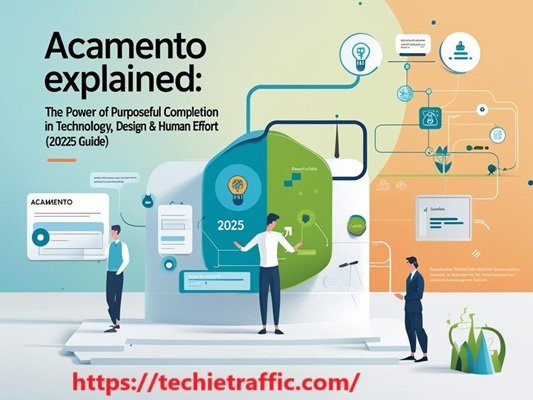In our fast-paced digital world, the word “Acamento” is beginning to stand out. Though not yet a mainstream term, it’s gaining attention in tech, design, education, and business. So, what does Acamento mean—and why does it matter in 2025?
What is Acamento?
Acamento refers to the purposeful act of completion. It’s more than just finishing a task—it’s about doing so with intention, refinement, and readiness. Whether in software development, education, project management, or even art, Acamento represents the final, meaningful step that ensures something is truly done and ready to deliver value.
Think of it as the difference between stopping and completing. Acamento adds polish, finality, and a sense of closure—an essential concept in a world filled with ongoing tasks and constant innovation.
Origin and Meaning of Acamento
Although “Acamento” is not originally an English word, its roots can be traced to Romance languages, particularly Portuguese and Spanish. The suffix “-mento” typically indicates a process or result. The prefix “aca-” suggests movement or transformation.
So, “Acamento” literally means the act of bringing something to its completed, final form. Similar words in Latin-based languages include “desenvolvimento” (development) and “estabelecimento” (establishment).
How Acamento Is Used Today
Acamento is a flexible term. It’s used in various fields, each applying it slightly differently but with the same core idea: meaningful completion. Let’s explore how Acamento fits into today’s key industries and systems.
1. In Software Development
In tech, Acamento describes the final phase of a software project, where the product is not only completed but tested, validated, and ready for deployment. Agile development often includes “mini-Acamentos” at the end of each sprint cycle—code is reviewed, bugs are fixed, and the output is shipped.
2. In Education
Teachers use Acamento to mark the end of learning cycles. This could be a final exam, a capstone project, or a portfolio presentation. These moments help students consolidate knowledge and transition to the next stage with confidence.
3. In Project Management
Project managers use Acamento to describe the closure phase of a project. This includes client sign-offs, documentation handovers, and team debriefings. Skipping Acamento can leave projects feeling incomplete or messy, which may harm outcomes or team morale.
Acamento in Language and Communication
In linguistics, Acamento symbolizes the final point in a sentence or speech when meaning becomes clear and fixed. It’s like the period at the end of a sentence—bringing closure to a thought or expression.
This concept is critical in:
- Proofreading and editing
- Finalizing new terminology
- Structuring meaningful narratives
Acamento in Art and Design
Artists and designers often struggle to know when a piece is “done.” Acamento helps define that moment. It’s the point where further edits don’t enhance the work—they just change it.
Applications include:
- Graphic design projects
- Film editing and storyboarding
- Architectural planning
Acamento ensures the original vision remains intact without endless tweaks that dilute the work’s power.
Cultural and Psychological Significance

Acamento is also present in our personal and cultural lives. Graduation ceremonies, weddings, and funerals all represent forms of Acamen to—marking the end of one chapter and the start of another.
Psychologically, humans crave closure. Our brains prefer stories and experiences that resolve neatly. Acamento acts like a mental checkpoint, reducing stress and giving a sense of accomplishment.
It plays a role in:
- Therapy (emotional closure)
- Education (learning milestones)
- Storytelling (satisfying endings)
The Role of Acamen to in Future Tech
As artificial intelligence, blockchain, and machine learning grow more complex, so does the need for clear endpoints. Without Acamen to, systems might loop endlessly, fail to make decisions, or become unstable.
Examples of future-tech Acamen to include:
- Completion of machine learning training cycles
- Final confirmation in blockchain transactions
- AI systems reaching logical conclusions
Well-designed Acamen to stages can make these technologies more reliable and user-friendly.
Why Acamen to Matters in Business
From Lean manufacturing to Six Sigma, Acamen to is vital for:
- Quality assurance
- Regulatory compliance
- Customer satisfaction
In UX (User Experience) design, companies like Duolingo and Airbnb use Acamen to concepts in progress bars, success messages, and onboarding flows to increase user engagement and satisfaction.
Acamento vs. Similar Terms
| Term | Meaning | How It Differs from Acamen to |
|---|---|---|
| Completion | Simple ending | Acamen to includes intentional refinement |
| Finalization | Technical wrap-up | Acamen to is more holistic |
| Closure | Psychological/narrative ending | Acamen to applies to productive settings |
| Termination | Abrupt stop, often negative | Acamen to is positive and purposeful |
Common Challenges with Acamen to
Despite its benefits, using Acamen to can sometimes cause confusion. Problems include:
- Miscommunication in global teams
- Premature closure without full evaluation
- Cultural differences in defining “complete”
To avoid these, organizations must define what Acamen to looks like in their workflows and teams.
Final Thoughts: Why Acamen to Is More Important Than Ever
As automation increases and multitasking becomes the norm, Acamen to offers something rare: clarity. It helps individuals and systems recognize when a job is truly done—and done well.
In 2025 and beyond, expect Acamen to to play a larger role in:
- Agile and DevOps workflows
- Educational design
- AI decision-making
- Human well-being and workplace balance


